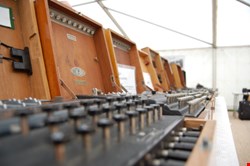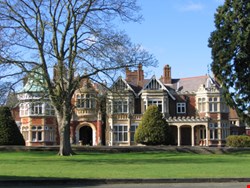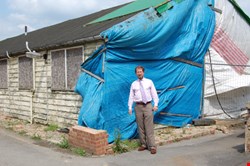


As known by any security professional, Bletchley Park was the centrepiece of Allied intelligence in World War II, responsible for the decryption of the German Enigma ciphers, and therefore a critical factor in the outcome of the war.
Originally a 19th century mansion, built in an eclectic mix of architectural styles and surrounded by parkland, the Park was converted to its wartime use in 1939, with makeshift blocks and wooden huts for almost 10 000 workers soon covering the estate. In size, Bletchley Park rivals the largest secret wartime facilities, such as Gretna. Nonetheless its existence and mission remained a secret throughout the war and were only declassified in the 1970s.
| "Bletchley Park helped shorten World War II by at least two years." |
| Simon Greenish |
The Enigma was originally a commercial encryption device that had been developed further by the Germans. It was at Bletchley Park that their codes were broken, based upon a known plaintext attack, exploiting upon the repeated use of phrases, names and locations, and the weaknesses in the Enigma. In Bletchley Park that decryption was turned into an industrialised process that gave the Allies the capacity and the scale to decrypt much of the German radio traffic.
Bletchley Park made an impact beyond the end of the war, laying the ground for post-wartime collaborations like the UK-USA Security Agreement, and its legacy is claimed by modern day intelligence organisations.
People
Bletchley Park has housed some of the most distinguished pioneers of the IT and security professions alike. Alan Turing was the cryptographer mastermind who enabled the breaking of the Enigma codes. His role and his life history will be celebrated in the Alan Turing Year, 2012.
Tommy Flowers commissioned the Colossus machine, the first programmable, digital computer. His accomplishments are being celebrated in the National Museum of Computing at Bletchley Park.
The real, unsung heroes are the men and women who worked in the huts at Bletchley Park, processing and decrypting messages, and thereby saving lives. It would have been standard practice that they weren’t allowed to tell anyone about their occupation, not even family members.
The UK government has only very recently taken the step to honour the few surviving Bletchley Park veterans in recognition of their accomplishments. In order to shed light on their lives and working conditions, the British Computer Society (BCS) Anniversary Fund conducted a project “Women of Bletchley Park”. Bletchley Park’s role has been memorised in a number of books and in popular culture by the half-fictional 2001 feature film “Enigma”, starring Kate Winslet.
Today
Grouped around the central mansion are the many blocks and huts of Bletchley Park. The museum’s exhibitions are housed in a number of buildings scattered across the site. The mansion is home to presentations and events, but the key exhibits are located in some of the huts and wartime buildings.
| "I was shocked by the widespread disrepair of the site, which I believe is a national disgrace." |
| Sue Black |
Space has been made for the main exhibition, and it displays in much detail the mathematical, technical and personal effort that went into decrypting the German codes. One of the most fascinating exhibits is the replica of the “Bombe” used during the war to semi-automatically decrypt messages.
A visit to the National Museum of Computing reveals more exhibits about the history of computing, and taking the time to see the rebuild of the Colossus, the world’s first programmable computer, is a must. Presentations at the mansion house give an insight into the basics of cryptography and the ciphering and deciphering of the Enigma machines.
Many of the buildings at Bletchley Park are sadly in visible need of repair, limiting space for suitable presentation of many parts of the collection. The exhibition of “Diplomatic Wireless Service” devices in Hut 1 is an example for how more space would benefit presentation of the displays. A number of supplementary exhibitions take the form of enthusiast collections, including model railroads, a small collection of historic cars, a hall with Churchill memorabilia and, somewhat anachronistically, a retired Harrier Jet.
Bletchley Park shows the potential of what it could become. Many of its exhibits may not be as outwardly spectacular as the airplanes and ships on display elsewhere – but by no means are they any less important, and owing to the secrecy surrounding Bletchley Park, one would expect the museum to be able to conduct significant historic research into the role of signal intelligence in World War II.
A lot still needs to be done to raise Bletchley Park’s treasures – and it’s running out of time.
The future of Bletchley
Besides enhancing and presenting its collection, Bletchley Park is faced with the dual challenge of countering the rapid erosion of its many historic buildings and upgrading its crumbling infrastructure, running into several million pounds. Detailed plans for modernisation have been drawn up, but without a doubt, Bletchley Park’s future will depend on retaining sufficient funds.
| "The Prince of Wales, on the occasion of a 2008 visit, called the Trust the "keepers of one of the greatest British success stories"." |
The Trust’s own website and statements in the press are underplaying its plight, but others are speaking out louder. Sue Black, head of department of information and software systems at the University of Westminster, started a campaign “Saving Bletchley Park” in 2008. She published an open letter in the Times last year with support from almost one hundred prominent academics.
In interviews, Black called the situation a “national disgrace” , encouraging voters on her website to write to their MPs. An e-petition to the Prime Minister to “Save Bletchley Park” raised almost 22 000 votes, and a motion to “call on the government to provide operational funding” in parliament has recently been launched. The Prince of Wales, on the occasion of a 2008 visit, called the Trust the “keepers of one of the greatest British success stories”.
Today, the Park’s biggest contributors include English Heritage Fund and Milton Keynes Council who between them found £1m to support the most urgent repairs. The UK government so far has been pushing back on getting involved in the fundraising effort directly, referring to the English Heritage Fund instead. In terms of private support, corporations like IBM and PGP have contributed US$100 000 to the National Museum of Computing located on the Bletchley Park site, and individual supporters are helping Bletchley Park with personal donations .
However, as Simon Greenish, the Trust’s director points out, the easiest way to support Bletchley Park is by visiting. It’s a great professional experience, suitable for a family day out and it demonstrates your interest in the most direct of ways.
Interview with Simon Greenish |
Simon Greenish is director of the Bletchley Park Trust. A civil engineer by profession, he joined the museum in 2006. Previously, Greenish was a member of the senior management team of the Royal Air Force Museum, London. Infosecurity Magazine: What is the historic value of Bletchley Park? Simon Greenish: It is a generally accepted statement that Bletchley Park helped shorten World War II by at least two years, potentially saving thousands of lives. Conceivably, without Bletchley Park our present world would be a different one. Its intelligence gave the fighting Allied armies the means to be successful. After the war, Bletchley Park was partly dismantled and remained hidden from the public until the 1970s. It has been a museum only since 1992, and it’s only now that its historic importance is being universally recognised. We have a number of related stories to tell – women at war; people who worked here like Alan Turing and Tommy Flowers; the world’s first programmable computer and the history of IT; and the basics of cryptography, to name but a few. The difficulty for us as a museum is that much of this story is an intellectual one. We can use the site itself and the instruments in our collection to illustrate some of it. However there are generally fewer artefacts, and it is therefore a story more difficult to relate to than, say, the history of aviation. That’s why Bletchley Park as a site is so important: It has a story to tell. IM: What are the challenges Bletchley Park has to face? SG: Three years ago there were challenges on many fronts, including maintenance of the ageing buildings. In the meantime, we were able to improve our financial situation and reduce operational costs, but some emergency repairs still occur. Providing a long term solution to these problems to enable the museum to stand on its own two feet will require a significant investment. The infrastructural challenges include the roads and installations on site and ensuring maintenance of the buildings, some of which have outlasted their originally anticipated period of use ten times over. Against all odds, the substance of the historic buildings is still in place. Only the F Block, which originally housed some of the Colossus machines, was demolished 22 years ago, before the founding of the Trust. We are still a very lean operation with a minimal number of staff. Nonetheless, visitor numbers have almost doubled since then, which is encouraging and visibly demonstrates the public’s interest in the site. Bletchley Park has gained a lot of profile over the past couple of years and its importance is recognised nationally and internationally. IM: How do you envision developing the museum once the infrastructure issues have been addressed? SG: With our stakeholders we have created a comprehensive plan on how to develop Bletchley Park into a modern museum over the next five years. To this end, we plan to consolidate the museum space and free up some of the area to become community space and enable commercial use where that can be done without affecting the substance of the historic buildings, such as for conferences and events. The Bletchley Park Trust is not receiving any funding for its operations, but we were able to secure funding for urgent building repair, such as the mansion roof, through a grant from English Heritage Fund and the local council. In addition, we are receiving donations from private individuals that go towards the maintenance of Bletchley Park. For the conversion and development of Bletchley Park, we have applied for a grant from the Heritage Lottery Fund with our detailed plan, and we’re currently awaiting their response. If all goes well, we hope to make Bletchley Park self-sufficient within the time frame of five years. It will then become a museum that reflects the site’s historic importance, presenting the visitor with a modern exhibition, including some of the private collections we have on site. IM: How can people support the cause of Bletchley Park? SG: Come visit Bletchley Park, and spread the news! |
Interview with Sue Black |
Dr. Sue Black is the head of department of information and software systems at the University of Westminster and is founder and former chair of BCSWomen. Black started the campaign website ‘Saving Bletchley Park’. Infosecurity Magazine: Why did you start a campaign to support Bletchley Park? Sue Black: I attended a conference at Bletchley Park and chanced to meet John Harper who was working on his ‘Turing Bombe’ reconstruction. He told me about the people side, and that’s what got me hooked. Bletchley Park wasn’t just the work of a single genius; it was the work of thousands of men and women. The BCS, with other organisations, later helped me set up a project ‘Women of Bletchley Park’. However, I was shocked by the widespread disrepair of the site, which I believe is a national disgrace. It is such a fundamental place for computer science and unique in its importance for the outcome of World War 2. It saved many lives and probably shortened the war significantly. I felt I needed to do something. IM: What are your campaign goals and what has been achieved so far? SB: Bletchley Park has always been ‘almost’ closing, ever since it was saved from redevelopment in the 1980s. Bletchley Park will need significant political support and commitment in order to survive. When I first took the initiative, it didn’t take long for almost 100 prominent people to pledge their support to an open letter in the Times. The BBC and print media then picked up the story. Later I started using social media, and in a short time we got several thousand people following me on Twitter. Bletchley Park was at the forefront of technology in 1939 – so it seems appropriate to use cutting edge technology in 2009 to bring it back to life. We started a petition which more than 21 000 people have signed, but the government is taking very small steps indeed.. IM: Who is supporting your campaign? SB: Professionals and academics and a number of parliamentarians are supporting Bletchley Park. Nothing is more important, however, than getting support from everyday people. In a nutshell, we need to save Bletchley Park while we still can. We need to save the site, but also the veterans’ memories. Time is running out. |
The Author
Dr. Peter Berlich, CISA, CISM, CISSP-ISSMP is an information security consultant. He is a former board member of certification organisation (ISC)² and of Information Security Forum.
References
- Devil’s Porridge
- The Alan Turing Year
- Kim Sengupta: “GCHQ releases the secret details of how Bletchley Park built the first computer”, The Independent, 2000-09-30.
- Mary Dejevsky: “Dad and a Family Secret”, The Independent, 2008-08-20.
- Andy McSmith: “Woman whose work saved a British convoy”, The Independent, 2008-08-20.
- “Bletchley Park Commemorative Badge”.
- Iain Thomson: “Government honours veterans of Bletchley Park at last”, v3.co.uk, 2009-07-10.
- “Women of Bletchley Park”.
- Enigma – The Movie.
- The National Museum of Computing.
- “Saving the heritage of Bletchley Park”, The Times, 2008-06-24.
- “'Neglect' of Bletchley condemned”, BBC, 2008-07-24.
- Petition to Save Bletchley Park.
- Phil Willis: “Funding for Bletchley Park”, Parliament Early Day Motion, 2009-07-20.
- “Can you help save Bletchley Park for the nation?”, Liberal Democrat Voice, 2009-07-21.
- “Royals at 'neglected' Bletchley”, BBC 2008-07-24.
- “English Heritage steps in to help save Bletchley Park for the Nation”, 2008-11-06.
- Stephen Adams: “WWII code-breaker home Bletchley Park gets vital repairs”, telegraph.co.uk, 2008-11-06.
- “Aid for Bletchley Park rejected”, BBC, 2009-05-22.
- Stephen Fry: “UK Snubs Support For Home of WWII Enigma”, eWeek Europe, 2009-05-20.
- Jack Riley: “Bletchley Park receives £57,000 donation”, The Independent, 2008-09-09.
- Bletchley Park Trust’s donation website.